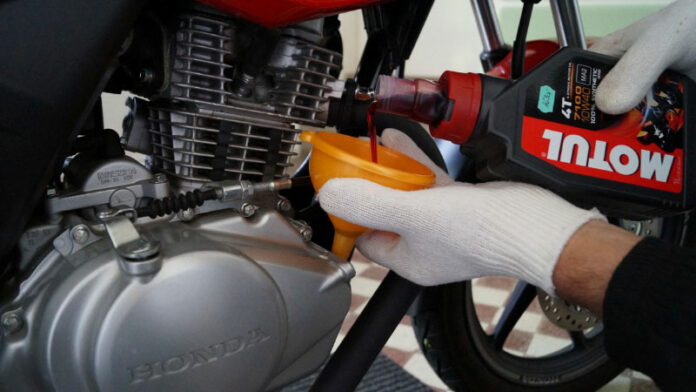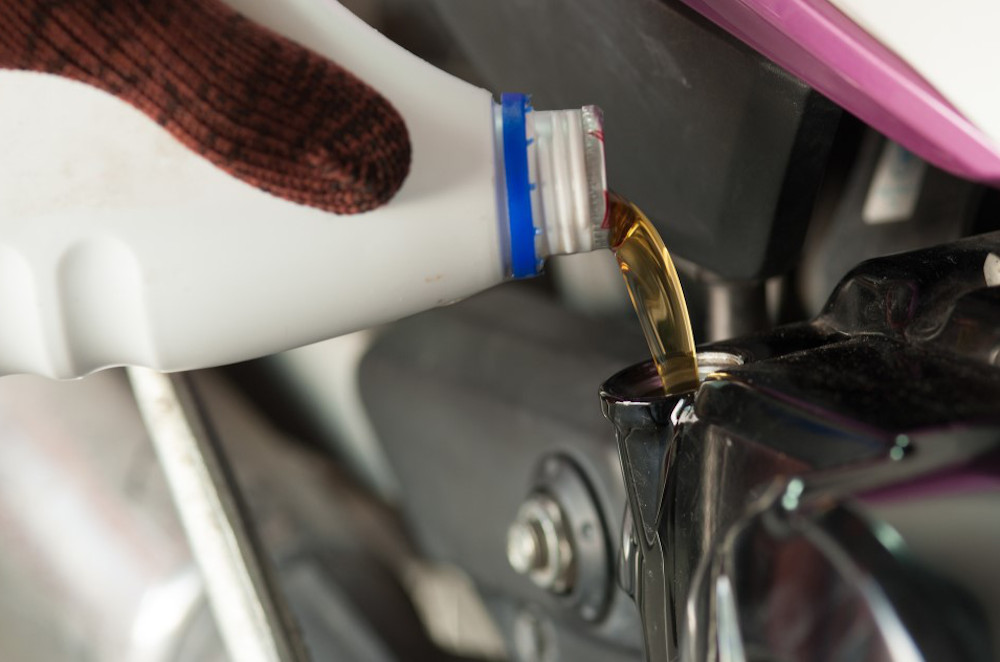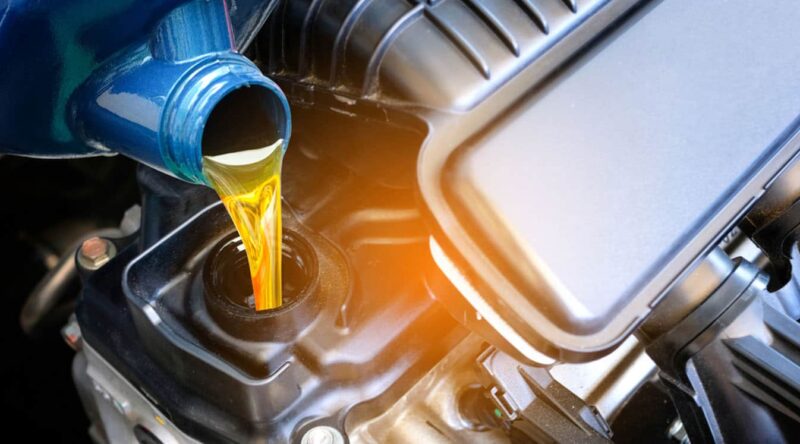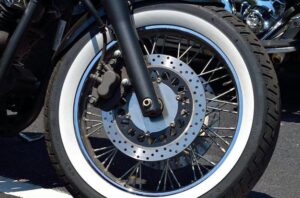Being a responsible motorcycle owner means maintaining your bike. Proper maintenance will not only keep your motorcycle in top condition, but it will also help you avoid any unnecessary problems in the future. An oil change is one of the most basic yet fundamental responsibilities. Motorcycle engine oil plays an important role in ensuring that all engine moving parts remain well lubricated. It also helps to clean the vital internal parts of the engine from tearing and wear. How Often Should You Change Your Motorcycle’s Oil?
Why Motorcycle Oil Matters
Engine oil lubricates moving parts while protecting the engine from moisture, combustion byproducts, and various additive contaminants. Unlike cars, most motorcycles also use oil as engine coolant, unless the motorcycle is specifically “liquid-cooled” The oil is also used to keep the motorcycle transmission cool and lubricated in place of the automatic transmission oil used in cars.
Unfortunately, the lubricating quality and protective additives of lubricating oils eventually break down when contaminants and moisture build-up. This is why motorcycle oil integrity must be maintained through regular changes and the use of the correct type of oil.
Different Types of Motorcycle Oil
- Mineral oil, also known as “traditional,” is a petroleum product made from refined crude oil. It’s a “fossil fuel” made by decomposing dead organisms underground. Although it is the cheapest and an effective lubricant, it contains a certain amount of impurities extracted from crude oil. Therefore, it breaks down faster and requires more frequent replacement than synthetic oil.
- These synthetic oils are produced from chemically modified petrochemicals rather than crude oil. They go through a complex production process to produce the exact chemical composition required for optimal engine lubrication while filtering out various impurities from mineral oil. Synthetic oils offer better engine protection and don’t break down as quickly as mineral oils, but they are much more expensive.
- Semisynthetic. These are blends of mineral and synthetic oils with 5 to 30 percent synthetic oil. As a blend, semi-synthetic oils offer an excellent compromise between the longevity and protection of synthetic oils and the affordability of mineral oils.
How Often Should You Change Your Motorcycle Oil?

There is no one-size-fits-all approach to how often or how often to change your motorcycle oil. In fact, how often a motorcycle needs an oil change depends largely on a variety of factors, such as:
- The make, model, and year of the motorcycle
- How often do you use your motorcycle
- Which oil do you use
In conclusion, the rules of thumb are clear:
You should change your motorcycle oil every year, or after 3000-5000 miles on your Motorcycle. If you use your Motorcycle more often, you should change your motorcycle oil more often, no matter what type of oil you use.
How To Check Your Oil Level and Condition
As we just mentioned, sometimes you don’t have to wait to complete the recommended miles to change the oil.
If you feel it’s affecting your bike’s performance or it’s dirty, that’s a good sign that you need to get new oil.
But how do you know the condition of your oil?
Depending on the model of motorcycle you have, you can check the oil level and condition using one of the following methods:
- Using the dipstick: You can simply pull out the dipstick to determine the oil condition. If the oil looks very dirty (very dark) or watery, it’s time to change the oil with fresh oil.
- The high and low marks on the dipstick will help you determine the oil level in your motorcycle’s engine. The ideal level should be between low and high scores.
- Remove the oil level plug: Use a wrench to help you easily remove the plug or bolt to help you check the oil condition and level. If the oil looks dirty, go ahead and change it.
- Use a viewing window: Some crankcases have a clear plastic window with high and low markings on the side. Use this to check if the engine oil is dirty or the oil level is too low.
Don’t forget that clean oil should appear brown or slightly black. Milky-white oil with metallic particles indicates that the oil is dirty and unsuitable. Low fluid levels also indicate a problem.
How and When to Change Your Motorcycle Oil

So you checked your engine oil and found it was dirty or low and needed to be changed.
What’s next?
Obviously, you should start thinking about changing your oil as soon as possible.
But how?
You can do the whole thing yourself with just a few basic tools. In the process, you’ll save some nice cash while learning more about your bike.
Let’s dive into more details on how to do this
What you need:
- Engine oil (follow the bike manufacturer’s oil recommendations)
- Oil pan/drain pan
- Brand new oil filter
- Oil filter removal tool
- funnel
- torque wrench
- socket and wrench
- Gloves
- a bundle of rags for cleaning
- User Manual
Once you have all the necessary tools and are ready to work, follow the steps outlined below to change the oil.
Oil change steps:
step 1. Prepare your motorcycle for an oil change by balancing on the stand (you can use the front stand, rear stand, or middle stand). Then place an oil pan just below the bolts into which the old oil will drain freely.
Pro tip: Draining warm oil is easier because it’s less sticky. So, consider letting the engine run for 5-10 minutes to warm up the oil.
Step 2. Grab the socket and wrench and use it to open the engine drain plug (turn counterclockwise). Remember to remove the gasket when cleaning and keep the stopper somewhere easy to trace.
Warining: If starting the engine as recommended above, avoid contact with hot parts of the bike.
Step 3. Now let the old oil drain completely from the bike engine. You can sit back and let it drain itself, or you can consider tilting your bike to eliminate any undrained oil levels.
Step 4. Next, you need to remove the old oil filter. Grab the wrench, place it on the filter, and unscrew it counterclockwise. Once the filter is removed, more old oil should flow out. Let it drain completely as well.
Step 5. Time to install a new filter. When you are satisfied that the filter/plug housing is completely emptied, remove the new filter and use your finger to apply some new engine oil to its seal (some manufacturers recommend that you Refill or direct oil; see owner’s manual for more information).
Hand tighten the new filter, then use the installed wrench to attach the adapter to tighten.
Step 6. Time to put the oil plug back in. Reinstall the new gasket on the engine drain plug and screw it into the oil pan by hand. Make sure to use a torque wrench (check the manufacturer’s recommended torque setting) to fully tighten it.
Step 7. Fill your engine with fresh oil. Remove the plug on the engine oil input port, insert the funnel, and start pouring in the oil. Again, you’ll want to consult your owner’s manual for the manufacturer’s recommended engine oil capacity to avoid overfilling.
Congratulations! You have successfully changed the engine oil of your motorcycle!
After filling the oil to the maximum level, let the engine run for about 5 minutes, making sure the oil pressure light goes out after starting the bike. Shut off the engine, check the oil level again, and adjust accordingly.
After the first proper ride (after an oil change), we recommend checking the oil level to see if it is at the highest level.
Final Word
Engine oil plays a vital role in keeping the moving parts of the engine lubricated while preventing them from tearing and wearing.
In order for the oil to continue to effectively protect your engine, you need to keep checking it and change it regularly with new oil.
The frequency of oil changes usually depends on the manufacturer’s recommendations. Experts also recommend that you change your oil every 3000-5000 miles or at least once a year.
Other factors, such as the environment in which you ride your bike, how often you ride, and the type of oil you use, can also affect how often you change your oil.



